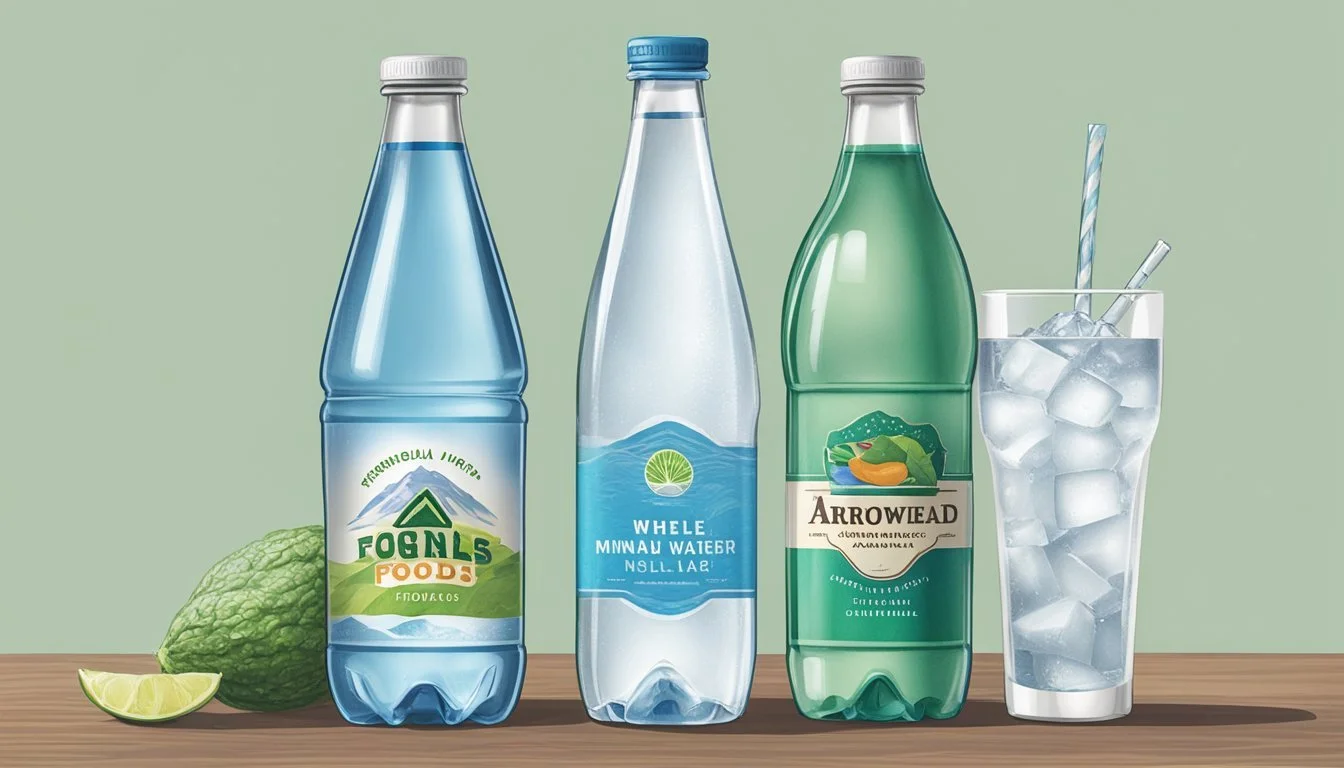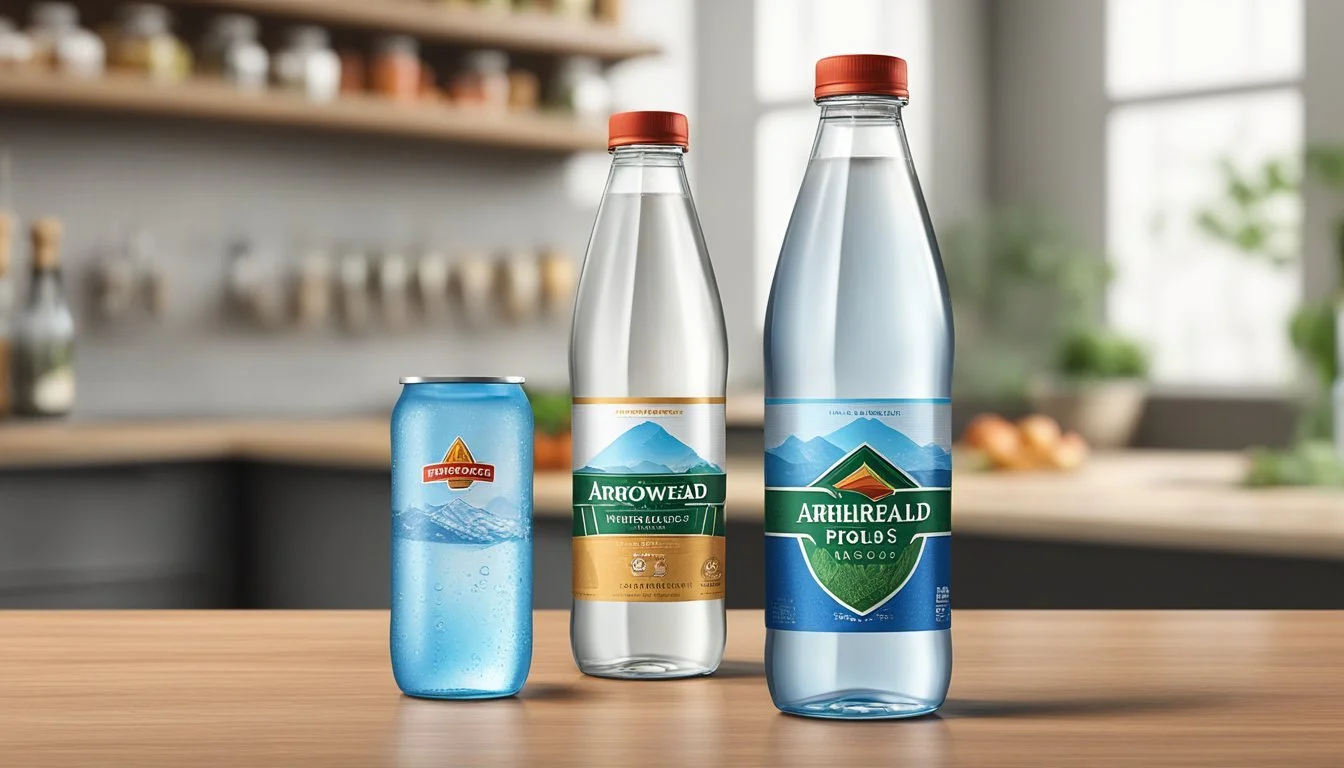Arrowhead vs. Whole Foods Italian Still Mineral Water
Comparing Quality and Taste
When it comes to choosing the best bottled water, discerning consumers often find themselves comparing brands like Arrowhead and Whole Foods Italian Still Mineral Water. Both aim to offer high-quality hydration, yet they differ in taste, mineral content, and source. If you're looking for a crisp and reliable taste, Arrowhead, sourced from carefully selected mountain springs, could be your go-to.
Whole Foods Italian Still Mineral Water, on the other hand, positions itself as a premium choice with its rich mineral content and smooth texture, sourced directly from Italy. This option not only provides hydration but also contributes to the subtle flavors that can complement a gourmet meal.
For those prioritizing health benefits, each brand offers distinct advantages. Arrowhead is recognized for its clean and revitalizing qualities, while Whole Foods Italian Still Mineral Water boasts a higher mineral content that can support bodily functions and overall wellness. Dive into the specifics to determine which aligns best with your lifestyle and preferences.
History and Origin of Bottled Water Brands
Bottled water has a rich history, stretching from early innovations in Europe to its expansion into the American market. Understanding the origins and historical context of water brands provides insight into their development and success.
Arrowhead: A Historical Perspective
Arrowhead Water, known for its natural mountain spring water, began its journey in the early 20th century. The brand sources its water from 13 springs across the Western United States.
Arrowhead taps into springs located in states such as Idaho, Nevada, and California. Their distribution focuses on the Western U.S., making it a household name in the region.
The brand’s dedication to providing high-quality natural spring water has cemented its reputation over the years. Their history is a testament to consistent quality and strategic sourcing from pristine environments.
Whole Foods and Its Italian Mineral Water
Whole Foods Market, recognized for its commitment to quality and sustainability, introduced its Italian Still Mineral Water to cater to the growing demand for specialty bottled water.
Sourced from renowned regions in Italy, the water reflects the country's reputation for purity and health benefits. Known for its mineral-rich content, Italian mineral water has been a staple in European households for centuries.
Whole Foods leverages this legacy to offer a product that appeals to health-conscious consumers seeking premium water options. Their choice to include Italian mineral water aligns with their overall mission of providing high-quality, natural products.
The Emergence of Italian Mineral Water in Grocery Stores
Italian mineral water holds a unique position in the bottled water market. Its emergence in grocery stores like Whole Foods can be linked to the European tradition of valuing mineral-rich sources deemed beneficial for health.
Italian brands pride themselves on water purity and the distinct mineral content that varies by region. This variety makes Italian mineral water a sought-after commodity in the global market.
Whole Foods' adoption of Italian mineral water into their offerings is a strategic move, tapping into a demographic that prioritizes health and quality. This trend has seen more consumers shift toward premium, internationally sourced bottled water.
Source and Composition of Mineral Water
When comparing Arrowhead and Whole Foods Italian Still Mineral Water, understanding the origins and mineral compositions of each brand is crucial. This ensures consumers make informed choices about their mineral water based on health benefits and unique properties.
Unique Sources of Mineral Water
Arrowhead water is sourced from various natural springs in California. These springs, located in the San Bernardino Mountains, provide water that is naturally filtered through underground rock layers, resulting in a refreshing and clean taste. Drawing from multiple sources ensures a consistent supply and quality.
Whole Foods Italian Still Mineral Water, on the other hand, is sourced from a single, pristine spring in Italy. Italian mineral waters, such as those from the Sibillini Mountains, are renowned for their purity. The water is collected at high altitudes, ensuring it remains free from contaminants and rich in natural minerals.
Mineral Content and Health Implications
Arrowhead water contains a balanced mix of essential minerals. It typically includes calcium, magnesium, and sodium, supporting bone health, muscle function, and electrolyte balance. The specific mineral composition may vary slightly depending on the spring, offering a natural and varied mineral profile.
Whole Foods Italian Still Mineral Water boasts a unique mineral composition with a focus on low mineral content. This type of water is often favored for its light taste and lower levels of sodium and magnesium, making it suitable for those managing their mineral intake. Despite the lower mineral content, it still provides essential benefits for hydration and overall well-being.
By choosing between these two brands, consumers can tailor their mineral water selection to their nutritional needs and taste preferences.
Taste Profile and Gastronomical Relevance
Understanding the taste profile and gastronomical relevance of Arrowhead and Whole Foods Italian Still Mineral Water is key to appreciating their distinct qualities. This section examines the unique flavors of these waters, the role of water sommeliers, and the specific pairings with food.
Taste Variations in Bottled Water
Arrowhead and Whole Foods Italian Still Mineral Water both offer distinct taste profiles shaped by their origins.
Arrowhead is sourced from multiple natural springs across the Western United States. It has a clean, crisp taste with a slightly balanced mineral content, which some describe as refreshing.
Whole Foods Italian Still Mineral Water is sourced from Italian springs known for their purity. It offers a subtle, smooth flavor with a faintly mineral aftertaste, making it ideal for those who prefer a milder taste.
The Role of Water Sommeliers
Water sommeliers are experts in the taste and quality of different bottled waters. They play a crucial role in helping consumers and restaurants select water that enhances their gastronomical experience.
These professionals can identify the unique flavor profiles of waters like Arrowhead and Whole Foods Italian Still Mineral Water. By analyzing the mineral composition and source, they offer insights into how the characteristics of each water can complement various types of foods.
Pairing Water with Food
Pairing water with food is becoming an increasingly refined practice. Just as wine is chosen to enhance a meal, selecting the right water can elevate the dining experience.
Arrowhead, with its crisp and slightly mineral taste, pairs well with hearty dishes such as grilled meats and rich sauces. Its refreshing quality contrasts richly flavored dishes.
Whole Foods Italian Still Mineral Water provides a softer, smoother flavor that is perfect for lighter fare like salads, seafood, or delicate pastas. Its subtle mineral content won't overshadow the delicate flavors of these dishes, instead offering a harmonious balance.
Through careful selection, both types of water can significantly enhance a meal, ensuring each dining experience is memorable and unique.
Environmental and Sustainability Considerations
When choosing between Arrowhead and Whole Foods Italian Still Mineral Water, environmental impacts and sustainability practices should be examined closely. This includes looking at eco-friendly practices, bottling processes, and the sustainability of water extraction.
Eco-Friendly Practices and Packaging
Arrowhead uses a mix of plastic and glass bottles, with efforts focused on increasing the recycled content of their plastic bottles. Glass bottles, often used by Whole Foods' Italian Still Mineral Water, are generally more environmentally friendly because they are more easily recycled and produce less waste.
Both brands have initiatives for reducing their carbon footprint. However, Whole Foods often emphasizes stricter eco-friendly practices in their packaging and offers a higher percentage of recyclable and reusable options.
The Impact of Bottling Processes on the Environment
The bottling process for both brands impacts the environment, but the effects differ based on the materials and scale of production. Arrowhead, predominantly using plastic, confronts challenges with plastic waste and higher greenhouse gas emissions in production.
Whole Foods, using more glass bottles, benefits from lower carbon emissions per unit compared to plastic. Glass bottling, although heavier and more energy-intensive in production, often results in less environmental degradation due to its longer lifecycle and higher recyclability.
Water Extraction and Source Sustainability
Arrowhead sources its water from springs primarily in California. Controversies have arisen regarding the sustainability of these sources, with questions on long-term availability and environmental impact.
Whole Foods Italian Still Mineral Water is sourced from Italian springs, often from highly regulated and sustainable water sources. Italian regulations frequently mandate strict sustainability standards, ensuring less environmental disruption and more sustainable water extraction processes. This often makes Whole Foods a preferable choice for those concerned with the long-term sustainability of their water sources.
Health Benefits of Staying Hydrated with Mineral Water
Hydration is key to maintaining good cardiovascular health and proper digestion. Mineral water offers additional benefits over tap water, including essential electrolytes.
Hydration and Cardiovascular Health
Staying hydrated with mineral water can significantly benefit cardiovascular health. Proper hydration helps maintain blood volume, aiding in the adequate functioning of the heart and blood vessels.
Mineral water, rich in magnesium and calcium, supports heart muscle function and helps regulate blood pressure. Studies have shown that magnesium-deficient individuals risk developing heart complications. Drinking mineral water ensures a steady intake of these crucial minerals, supporting cardiovascular health.
Moreover, hydration helps in the efficient transport of nutrients and oxygen to cells, reducing the workload on the heart.
The Role of Electrolytes in Digestion
Electrolytes play a vital role in digestion, and mineral water is a natural source. Electrolytes like sodium, potassium, and chloride help regulate the fluid balance in the intestines, which is crucial for proper digestion.
Sodium in mineral water aids in nutrient absorption, while potassium helps with muscle function, including the muscles in the digestive tract. This can prevent issues like constipation and improve bowel movements.
Mineral water can also stimulate the production of digestive enzymes, thereby promoting better digestion and nutrient assimilation. Drinking mineral water regularly can ensure that the body maintains a healthy electrolyte balance to support efficient digestion.
Mineral Water vs. Tap Water
Mineral water and tap water both serve the purpose of hydration, but they differ significantly in composition. Mineral water contains naturally occurring minerals like calcium, magnesium, and potassium. These minerals not only enhance the taste but also provide added health benefits.
Tap water varies widely in mineral content depending on geographic location and treatment processes. Some tap water may lack essential minerals; meanwhile, it can contain contaminants like chlorine and fluoride.
Choosing mineral water over tap water can ensure a consistent intake of beneficial minerals while potentially reducing exposure to unwanted substances. For those looking to maximize their hydration and mineral intake, mineral water is a favorable option.
Consumer Choices and Preferences
When choosing bottled water, factors such as brand reputation, luxury perception, and mineral content play crucial roles. Understanding these elements can help consumers make informed decisions.
Evaluating Brands: From Worst to Best
Consumers often rely on brand evaluations to choose their bottled water. Arrowhead and Whole Foods Italian Still Mineral Water feature prominently in many rankings.
Arrowhead has been criticized for its taste, often landing in lower tiers in blind tests.
In contrast, Whole Foods’ offering is appreciated for its clean and pleasant flavor, earning higher spots in lists such as the Los Angeles Times’ rankings. Consumers should note that such evaluations are subjective but provide valuable insight into general preferences.
The Luxury Factor in Bottled Water Selection
Luxury plays a significant role in bottled water choices. Brands like Whole Foods Italian Still Mineral Water are often seen as premium due to their source and packaging.
Glass bottles and imported labels add to the perception of luxury, making them popular in upscale dining settings. The association with high-end cuisine and wellness trends further elevates these brands in the eyes of discerning consumers.
In contrast, Arrowhead is more commonly seen as a practical choice, often available in bulk and favored for everyday use.
Understanding Water Labels and Mineral Composition
Water labels and mineral composition are crucial for informed choices. Bottled water can vary widely in its mineral content, affecting both taste and health benefits.
Whole Foods Italian Still Mineral Water typically highlights its unique mineral composition, often containing minerals like calcium and magnesium, which contribute to its smooth taste. Reading labels can inform consumers about the source and potential health benefits.
Arrowhead might not boast the same richness in minerals but is recognized for its reliable consistency and availability. Consumers interested in specific health benefits should compare the mineral content listed on the labels of different brands.
Regulatory Standards and Water Quality
Regulatory standards and water quality are critical factors when comparing bottled water brands. Understanding the role of industry organizations, investigative journalism, and contaminants affecting consumers can help make an informed choice.
Overview of the International Bottled Water Association
The International Bottled Water Association (IBWA) sets stringent guidelines for bottled water quality. These standards often exceed those set by local governments. The IBWA focuses on ensuring water is free from harmful contaminants such as lead, PFAS chemicals, and other heavy metals.
Members of the IBWA must adhere to these guidelines, which include regular testing and compliance checks. This commitment ensures the bottled water you consume is safe and pure.
The Role of Investigative Journalism in Water Quality
Investigative journalism has played a significant role in uncovering the truth about bottled water quality. Articles in reputable sources have highlighted discrepancies in water sources and testing practices.
Consumer Reports, for instance, has found toxic PFAS chemicals in several popular brands. Investigative journalists help hold companies accountable by bringing such findings to public attention, ensuring consumers are informed about potential risks.
Contaminants and Purity: PFAS Chemicals, Lead, and Heavy Metals
Contaminants like PFAS chemicals, lead, and other heavy metals pose serious health risks. PFAS, or per- and polyfluoroalkyl substances, are often found in bottled water and linked to cancer and liver damage. Lead contamination can result in neurological issues, particularly in children.
Regular testing is essential to prevent exposure to these toxins. Brands adhering to strict regulatory standards are less likely to contain these harmful contaminants, ensuring safer drinking water.
Trends and Innovations in the Bottled Water Industry
The bottled water industry has seen significant shifts in both consumer preferences and technological advancements. Key trends include the growing demand for alkaline and boxed water, the rise of new brands, and the use of advanced filtration techniques to ensure water purity.
Rising Popularity of Alkaline and Boxed Water
Alkaline water, known for its higher pH level, is gaining traction among health-conscious consumers. Believed to neutralize acid in the body, it is marketed for its potential health benefits.
Brands like Essentia and Core have seen increased sales, reflecting this growing interest. Boxed water, on the other hand, aims to reduce plastic waste. Companies such as Boxed Water Is Better emphasize environmental sustainability by using recyclable packaging.
The Emergence of New Water Brands
New water brands are continually entering the market, each seeking to create a unique identity. These brands often focus on niche markets or specialties, such as infused waters or eco-friendly packaging.
For instance, brands like Liquid Death and Hint have gained popularity through distinctive marketing strategies and product innovation. This diversification caters to varying consumer preferences, driving competition and innovation within the industry.
Advanced Filtration Techniques and Water Purity
Ensuring water purity through advanced filtration techniques has become a priority. Technologies like reverse osmosis and UV filtration are commonly employed to remove contaminants and improve taste.
Brands like Smartwater use vapor distillation, which purifies water by turning it into vapor and then condensing it back into liquid form. These advanced methods reassure consumers about the safety and quality of their bottled water.
Concluding Remarks on Choosing Quality Bottled Water
When selecting quality bottled water, consumers should consider several factors. These include source, treatment process, and mineral content. Bottled waters vary widely, from natural spring water to Italian mineral water.
Natural spring water is collected where it naturally surfaces. It usually contains various minerals beneficial for health. Arrowhead is an example of this type.
Italian mineral water like Whole Foods Italian Still Mineral Water is sourced from protected underground reservoirs. This water type is naturally enriched with minerals like calcium and magnesium, contributing to taste and potential health benefits.
Key Considerations:
Source: Determines mineral content and purification needs.
Treatment Process: Impacts taste and purity.
Mineral Content: Essential for taste and potential health benefits.
For those prioritizing natural and mineral-rich options, Italian mineral water might be preferable. Meanwhile, those who prefer water from a natural spring might lean towards options like Arrowhead.
Understanding these elements helps make an informed decision based on quality, taste, and health benefits.








